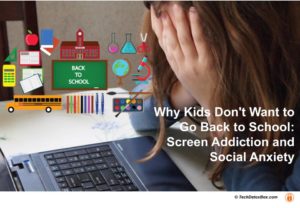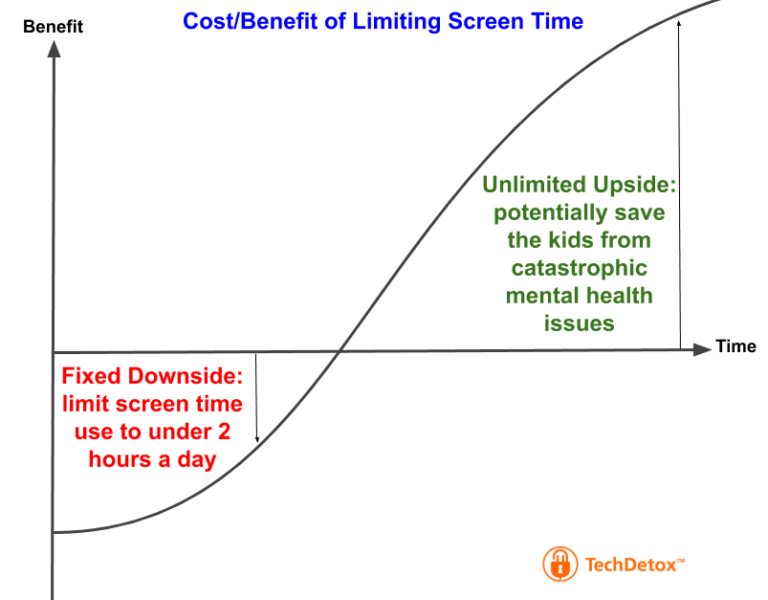
Kids don’t want to return to school because their comfort zone is now the size of their screen.
It is important to separate genuine social anxiety (I don’t want to go to school because I am afraid of people) from laziness (I don’t want to go to school because I prefer to play video games), but both have the same remedy – put the screen away and return to the real world.Tech-Induced Social Anxiety
- Screen-based socializing replaced face-to-face communication. Social skills atrophied.
- Real life relationships became too much work compared to digital ones.
- Kids became emotionally fragile, seeing real life social feedback as traumatic.
- Empathy diminished as screens and masks deprived kids of non-verbal cues.
The Elephant in the Room
This summer a friend of mine announced excitedly to her children that finally – after a year and a half stuck at home – they are going on vacation! Isn’t that awesome? Where would they like to go?
“Nowhere. We’d like to stay home and play video games all summer” – replied her two boys.
Screen time doubled during the pandemic. Video game industry grew by billions of dollars.
Of course, it did. Kids were stuck at home. Parents were trying to work, which requires that kids be QUIET. The only way to keep kids from destroying parents’ careers and sanity was screens. During school – YouTube was now “education”. After school – as video games and social media filled the vacuum created by cancelled activities and social distancing.
This went on for 18 months. And then schools have reopened.
Only by now, spending their entire life on the screen was the new normal for children. They were not interested in anything else.
Is School Refusal… a Withdrawal?
The more kids indulged in highly addictive screens during the lockdown, the more dopamine hit their young brains, and the faster it was desensitized to its effects. Kids now needed more screen time to get the same “high”.
During the pandemic, children came to take unregulated screen access for granted – parents and schools had no choice, and dopamine flowed freely. As schools reopened for in-person learning, cozy screen time days were abruptly interrupted. 12 hours a day became 3.
With the return of in-person learning and resumed after-school activities, kids’ intake of the digital drug was greatly reduced.
What happens to the brain on drugs when the drug is taken away?
Could school refusal be the pain of an addict deprived of their “drug of choice”?
Are the kids going through withdrawal?
Pandemic Damage
Screens have been damaging young brains way before COVID-19. What the pandemic did was supercharge the process of human downgrading:
- Catastrophic increase of screen time
- Social isolation with negative consequences for mental health
- Destruction of familiar routines
- Communication compromised by masks
- Family tension
- Poor fitness, diet, and hygiene (kids in pajamas all day)
- Loss of discipline and focus
- Intellectual degradation
Let’s face it, not much learning was happening with YouTube and video games always on. Frazzled parents who worked remotely did not have the time to monitor if children were getting a proper education.
A Screen Is Not A Classroom
With distance learning, kids could google test answers any time they wished. Thanks to the pandemic, students could obtain high grades and test scores by cheating – no one would ever know. The lazy path of least resistance ruled the day.
Distance learning was a fake education.
Besides, teachers could not control if students were distracted by the next Tik Tok video. The other side of the screen is not the classroom. Naturally, kids only paid partial attention to their studies, multitasking between multiple screens at home. School phone policies were suspended, all bets were off.
It’s a traditional school that requires mental effort. The days of laziness, sleeping in, and gaming are replaced with classes, sports, and homework.
Doing the hard work of learning instead of outsourcing it to Google.
Suddenly, teachers are back in control. They can ask the students to put the phone away in (some) forward-looking schools. Here is an excerpt from our district school policies:
Cell Phone Rules
Students are permitted to bring cell phones and electronic devices (EDs) to school under the following conditions:
1. Cell phones / EDs must remain off from 8:05 am until 2:50 pm.
2. Cell phones / EDs will be confiscated if powered on and or in use …on first offense.
3. Confiscated cell phones / EDs will be returned only to a parent / guardian.
4. Third confiscation warrants permanent loss of cell phone / ED privileges.
5. Using a cell phone / ED to bully, harass, intimidate, or spread ‘rumors’ about another student shall result in permanent loss of cell phone privileges and the police may be notified.
I love our school. 🙂
Phones are a distraction. Teachers shouldn’t have to compete with TikTok.
During the pandemic, kids and phones had no reason to separate, but a return to in-person learning also marked a return of phone separation anxiety, a condition called nomophobia.
Teachers are asking to put that phone away – and students refuse to go to school where such injustice happens!
School As a Distraction
With screens so engaging, kids started to view every other human activity as a waste of time. A distraction. That’s not some nebulous theory – my own kids circle the clock every night waiting for their screen time to commence. Only after the pandemic, their sacred right to evening screen time is violated by sports, and they protest!
What’s a reopened school if not a whole day distraction from screen time?
Addiction By Design
Today’s screens are different from the TV of old times, when the cartoons were over and it was time to do something else. Addictive digital media will never give the child a reason to put it down. The next video is more interesting than the previous one. Can’t miss it. The next round of the game can’t wait – by design.
Bad habits are difficult to break, and screen time habit got a boost during the pandemic:
- Screen Time Quantity: Captive audience chained to screens.
- Screen Time Quality: The chains got stronger.
At the heart of user experience (UX) design is the dark psychology that takes advantage of human vulnerabilities. Which is particularly effective when it comes to children with their immature brains.
Triggers for compulsive use evolved through the pandemic as social media and video game designers made user experience more irresistible and sucked our kids deeper into the digital universe.
Easy and Fun
Being on the screen that showers the brain in feel-good dopamine every few seconds feels better – and less risky – than trying to get social validation in person. None might be given, so why bother? So much easier to stay home and indulge in favorite online pastimes.
On social media, kids are collecting “Likes” and “Friends”, and feel like they are socializing, mistaking the feeling for happiness. In video games, they collect points, mistaking the feeling for success. It is easy. It is fun. According to psychologist Richard Freed, PhD, screen activities replace difficult but developmentally important activities of childhood. While digital media companies continue to profit from compulsive use.
With instant results on the screen, no delayed gratification is required. I am being social! I am growing my network! But the sad reality is that kids are in solitary confinement in their rooms, while real human skills they would need for college, work, and future family are deteriorating.
A Way Out: Don’t be COVID-Scared
> Validate their feelings. Social anxiety may not be rational, but it’s real. You cannot argue with a feeling, accepting it is the first step to heal.
> Curb your own anxiety. When parents freak out, so do the kids. It’s not good for children to be COVID-scared of their teachers and classmates.
Kids mirror their parents’ anxiety. One of our family friends is a school psychologist. His advice for reducing kids’ anxiety was to perform a “parentectomy”. The best thing you can do for them is to stop being COVID-scared of the world. The stories in the media are designed to keep us glued to the screens in fear. Millions of kids who recovered from COVID like they would from a regular cold do not make the news.
> Exposure Therapy. A treatment for any irrational phobia is repeated exposure to the object of fear. Afraid of snakes and spiders – spend more time around them. Afraid of people?
The cure for social anxiety is to hang out with people again.
The cure for school refusal is to go back to school.
COVID lockdown was hard. The real damage from the pandemic was not to children’s physical, but to their mental health. Young brains got hit with a toxic overdose of screen time and social isolation.
With schools and activities back in session, life is hectic again, but busy schedules are better for our children than life on screens. Kids’ humanity suffered during the pandemic. They need to return to the real world – to heal and to thrive.
So send them back to school. Sign them up for sports.
Discomfort is the key to overcoming social anxiety, and every time kids venture out they get stronger.
One of my son’s friends needed permission from the school counselor to be allowed in the school building because of social anxiety around large groups of people. He finally went, and he is loving it.
Think of the alternative. If they stay in their room, they will forever live in fear of people. We all have to deal with each other in person, not just on the computer screen and on social media. Social skills and emotional intelligence acquired face to face would give children an advantage over their peers who opted out of life and turned into digital zombies.
Send the kids back out. It’s good for them.
Take Back Control
Sign up for our monthly newsletter to receive latest digital wellbeing research and screen time management solutions. We never share your email with third parties.Share this:
- Click to share on X (Opens in new window) X
- Click to share on Facebook (Opens in new window) Facebook
- Click to share on LinkedIn (Opens in new window) LinkedIn
- Click to share on Pinterest (Opens in new window) Pinterest
- Click to email a link to a friend (Opens in new window) Email
- Click to print (Opens in new window) Print




